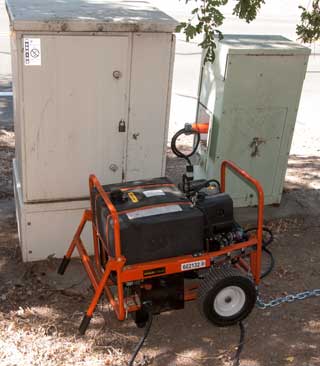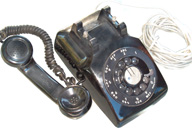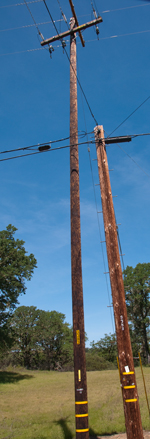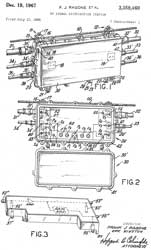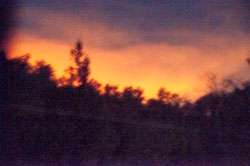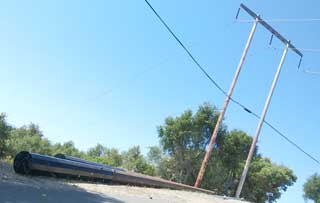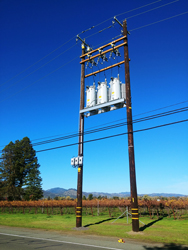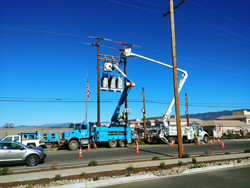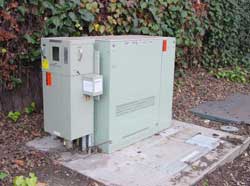The End of AT&T Landlines
© Brooke Clarke 2024CPUC Actions Related to Landlines
Possible AT&T Actions if they get approval
Description
The Communications Act of 1934 & Amendments
Landline Telephones
Business Lines
Availability
DSL Up Time
DSL Abailability
Central Office Powers System
Repair & Maintenance Costs
Reliability, Robustness & Resilience
Copper v Glass & Air
AC Power Grid Outages
Historical
After 2017 Wildfires
PG&E Grid Upgrades
No New Sources of 24/7 Electricity
Forecast More Power Failures
Forecast Emergency Communication Failures
Comcast and other Hybrid Fibre-coaxial cable TV systems Fail
Fiber To The Home Probably Fails
Wireless Internet Service Providers (WISP) Fails
Voice Over Internet Protocol (VOIP) Fails
Cell Phones Fail
Backup Power Legislation
CA SB431
FCC Order 07-177
Satellite Based Internet Fails
StarBand
Starlink
Related
References
Links
Background
Starting around 2000 (see Rural Internet Timeline) what in hind sight were poor decisions were made about what was at the time considered "entertainment" rather than what we now know should be considered a vital public utility, i.e. the internet. magicJack (Wiki) provided low cost VOIP telephone service starting in 2007. VOIP also has become part of business phone systems (Wiki: Cisco - VOIP).
The problem is that these modern phone services were designed to be neither resilient nor 911 compatible. They were an add on to the internet with the intention of providing low cost phone service. But the people buying them were not told that they would fail in a emergency.
In a similar fashion cell phones were an add on to the landline system to provide mobile phones with no thought to resilience.
By design VOIP, cell phones and systems based on glass fiber optic cables will fail when the power grid fails unless there is specific provision for backup power.
When a natural disaster strikes like Hurricane Katrina (Wiki: 2005), or the wildfires in California there's a hearing about the failure of the water mains, the electrical grid, communications, &Etc. But the communication failures are not dependent of the type of natural disaster. That's to say all kinds of natural disasters will cause the electrical grid to go down, it's not just wildfires. For example Earthquakes, tornadoes, hurricanes, floods, landslides, heavy rain, Tsunamis, &Etc will cause the electrical gird to fail and that will cause communications failures. I mention this because a lot of the CPUC documents mention the idea of only requiring backup power for facilities in high fire danger locations. That's a big mistake.
If cell phones were useful at people's homes they would adopt them and get rid of landlines. Those still using landlines (and paying over $100/month) are doing so because they are worth the money because they can be relied on in emergencies.
CPUC Actions Related to Landlines
A23-03-002 Withdraw ETC (Eligible Telecommunications Carrier)
A23-03-003 Withdraw COLR
Jan 2024 an AT&T repairman informed us that AT&T was in the process of discontinuing landlines for both telephone and DSL service in California.A22-03-016 GO 133 Minimum Service Standards
I checked with Huffman's office and they sent a link to the CPUC proceeding A2303003 main document.
https://docs.cpuc.ca.gov/PublishedDocs/Efile/G000/M502/K977/502977267.PDF
This document contains the AT&T proposal and a white paper by Mark A. Israel based solely on economics. There is no technical discussion.
The top CPUC web page for proceeding A2303003. Under the tab "Documents" there are many documents.
This is about all the complaints to the CPUC about the landlines not working and AT&T's inability to make repairs.
Service Quality and Eligible Telecommunications Carrier (ETC) -
Communications Network Resiliency - Tier 2 & Tier 3 (High Fire Threat area map) (SB341 is typo, sb SB431).
CalOES - 911 Outage Map (with links to provider outage maps)
Decision 21-02-029 February 11, 2021: Decision Adopting Wireline Provider Resiliency Strategies - poor goal setting only "resiliency planning for communications providers in areas prone to outage events and wildfires," How short sighted. California is known for other natural disasters such as Earthquakes, flooding, land slides and Tsunamis where reliability of communications is vital.
D.20-07-011 Decision Adopting Wireless Provider Resiliency Strategies (Ref 6) - Many important concepts!
Service Quality - Minimum service standards for wireline carriers -
DocumentsCommunications Network Resiliency - only for Tier 2 and Tier 3 High-Fire Threat Districts!
G.O. 133-D Rules Governing Telecommunications Services
D.16-08-021 (Aug 18, 2016) Decision which adopted G.O. 133-D Rules governing telecommunications services.
D.16-10-019 (October 12, 2016): Decision correcting minor errors in the general order that were adopted in the first decision.
Fire-Threat Maps and Fire-Safety Rulemaking - Hi res HFTD poster map.pdf - most of Mendocino county is Tier 2, some Tier 3
Network Exam of AT&T and Frontier/Verizon 2018-2019 -
Key Findings from Network Exam Phase I Study:
1. Service Quality has deteriorated – Both carriers exhibited a higher relative number of outages and longer time required to restore service for outages lasting more than 24 hours.
2. Demonstrated lack of resiliency – AT&T and Frontier are not always maintaining networks to withstand environmental and weather-related conditions. Networks are not robust, both Incumbent Local Exchange Carriers (ILECs) have cut back on preventative maintenance expenditures.
3. Disinvestment in Plain Old Telephone Service (POTS) – AT&T and Frontier are putting very little investment into infrastructure that supports only Time Division Multiplexing (TDM) service. Both ILECs are relying on price increases and customer inertia to maintain the revenue stream.
4. Increased investment in broadband improves POTS service quality – AT&T and Frontier areas with higher broadband investment have a higher level of POTS service quality and better performance on all General Order 133-D metrics.
5. AT&T is focusing on higher-income communities – AT&T wire centers serving areas with the lowest household incomes exhibit higher trouble report rates and longer out-of-service duration compared to the areas of higher-income communities.
6. Direct relationship between the amount of competition and service quality results – Areas with limited or no competition experience lower service quality results. Both AT&T and Frontier put more investment and attention in areas with higher rates of competitive offerings.
4A. SQA AT&T: Northern California, for example, has seen a 34% increase in the rate of OOS per 100 POTS lines in service over the study period.
Table 4A.1 Large wire centers have had a drop-off of 72% (8 million lines to 2 million lines) but small wire centers have seen only 54% drop-off (43 thousand to 20 thousand lines). Maybe because landlines are more critical in rural areas?
9. Safety, Redundancy & Resiliency AT&T
47 CFR, Chap. 1 FCC, Part 12.4 Resiliency, Redundancy and Reliability of Communications/Reliability of covered 911 service providers: With respect to any central office it operates that directly serves a PSAP, a covered 911 service provider shall certify whether it:
(A) Provisions backup power through fixed generators, portable generators, batteries, fuel cells, or a combination of these or other such sources to maintain full-service functionality, including network monitoring capabilities, for at least 24 hours at full office load or, if the central office hosts a selective router, at least 72 hours at full office load; provided however, that any such portable generators shall be readily available within the time it takes the batteries to drain, notwithstanding potential demand for such generators elsewhere in the service provider's network.
(B)????
Possible AT&T Actions if they get approval
At the 4pm Public CPUC meeting in Ukiah on 22 Feb 2024 after my comment that landlines were the most reliable voice communication system (Ref 12) one of the judges asked Tedi Vrihesa, who gave the AT&T opening presentation, what would replace the landlines. Her response was something like we will figure that out later. At the 6pm meeting that was expanded to say it would be a combination of wireless services and fixed outside plant.
Fiber Optic
On this page I have detailed that any system that makes use of glass fiber optic cable imposes a requirement for a generator at both ends of the cable to power the associated electronics if the 72 hour backup power requirement is to be met.
Wireless
A wireless solution would be very difficult because of the mountains and trees in this area. This can be seen in the very poor wireless coverage here now. I have a cell phone but it does not work at my house. If I drive for half a mile it will work. But at my age there's no way I could walk up that hill. Also with an AC grid power failure the vast majority of cell phones will not be able to be recharged.
I'm concerned that AT&T will use the CPUC Broadband Map to determine what wireless services are available. The Mobil internet tab has eight lines of providers, but none of them work at my house. Three of the providers show have zero for either the upload or download speed.
The other concern is they will pawn off on me a WISP or ISP that will go down shortly after there's a power failure.
Satellite
Phones
This might work. Iridium (Wiki) or other satellite phones (Wiki) should work if there's a clear view of the sky. But when I looked into getting one the monthly cost was many hundreds of dollars. You can buy minutes, but they expire which amounts to many hundreds of dollars per month.
Internet
The Starlink satellite (Starlink, Wiki) system is still being launched. I have experienced a 20 minute outage during which there is no way to contact technical support since their system is down. But in theory their system should be robust, resilient and reliable. But it is not viable in locations that do not have a clear view of the sky, such as in a forest or a house surrounded by trees. I regularly my phone change WiFi sources because Starlink drops out of around a second. This happens many times a day.
Emergency Notification (Wiki)
"Typical users/purchasers of satellite SOS button devices are participants in activities such as hiking, mountain biking, climbing, boating and flying. They are also useful for those who work in remote areas (loggers, foresters, geologists, fisheries and wildlife staff)." This system would not replace a landline phone, but would be a way to call for help. It probably would not work for an emergency notification, like to evacuate.
My Ideal Solution
A Fiber To The Home (Wiki) system where a copper cable is pulled alongside the FO cable to supply power for the home electronics. Power Over Ethernet (Wiki: POE) can supply up to 70 Watts using a voltage below 60 VDC. This gets around the problem that glass is an insulator and can not be used to carry AC or DC power.
Selling Landline
In other states AT&T has divested their landline infrastructure by selling to a much smaller phone company. In all the cases I know about that smaller company has gone bankrupt allowing the landline system degrade to the point of being useless. This is a very bad situation.
Other?
If you know of some other solution please let me know.
Description
The Communications Act of 1934 & Amendments (Wiki)
I thought this was the source of the requirement that the phone system be very reliable. But so far have not found that reference.
1. General Provisions
2. Common Carriers (pg 35)
P1. Common Carrier Regs3. Radio
P2. Develop Competitive Mkts
P3. Re Bell Operating Companies
4. Procedural & Admin Provisions
5. Peanl Provisions - Forfeitures
6. Cable Coms
7. Misc Provisions
Internet
Note that when the FCC removed internet service from Title II it was saying that internet was not a vital public utility. That in turn means there is no provision that the internet work in a emergency.
The same goes for cell phones. i.e. they are not considered essential public utilities and so there's no requirement for backup power. For example see the list of objectives for the Telecommunications Act of 1996 (Wiki, Wiki) where essential public utility is not mentioned, only economics and competition.
See my Rural Internet Timeline at 2002 & 2005 where internet service providers were removed from CAof 1934 so not treated as utilities."public interest, convenience, and necessity" is a phrase that shows up. What does it mean?
Landline Telephones
I remember going on a tour of a Central Office and it was pointed out that some lines, like those used by Air Traffic Control, were a priority to keep working. The brick building had no windows and looked like it was bomb proof. That's to say it would work in a natural or man made disaster.
As far as I can remember part of the deal allowing AT&T to run the monopoly of the telephone system is that the system be reliable and importantly work in emergencies.
This may be part of the Communications Act of 1934. For example:
- The Central Office buildings are constructed to survive natural disasters like fire, earthquake, hurricane, tornado &Etc. They include backup batteries and generators. Note the landline system is all powered from the central office, that's to say the phones do not need batteries or a connection to the AC power grid.
- Every phone line has a lightening protector (see: Fig 11 black devices with white circle, Station Protection).
- The 500 dial and 2500 Touch Tone telephones are very rugged and will continue to work after suffering a lot of abuse. Even an antique phone will still work today.
Business Lines
AT&T provides landline telephone service underFCC Title IIof the Communications Act of 1934. This means they must work in an emergency.
My main concern is getting reliable communications during an emergency, like wildfires.
But many businesses depend on phone systems rather than individual phone numbers. That's to say a business with multiple lines can not easily switch to cell phones for their lines. They probably have or will switch to VOIP for their telephone system. The problem with VOIP is that it fails for a number of reasons (see VOIP Fails).
Landline Availability
I've heard a rumor that new landline connections have not been available for for many years.
DSL Up Time (Wiki)
Is provided using the copper wire pair associated with a landline telephone. In order to meet the emergency requirements for the landline phone DSL also works when the AC power grid is down.
I've been told by AT&T repairmen that DSL works even when the voice line has failed. This is because DSL dynamically chooses the frequency bands that work and avoids the frequency bands that have a problem. So a VOIP circuit provisioned on DSL is more reliable than the underlying voice circuit.
DSL Availability
For many years new DSL connections have not been available here. I used to think it was because the DSLAM was totally subscribed and AT&T did not want to put in another one, but it may be that they simply did not want more landline accounts?
DSL has provision for generator backup.
The wild fires starting in 2017 causes the AC power to fail here.
This was the first time I experienced AT&T deploying backup generators to keep my DSL working. The first time (2017) it took many hours for the backup generator to be installed and working. But in 2018 and 2019 the generator was on line within an hour.
In 2018 it took waiting in long lines to get gasoline since there were only 2 gas stations that had backup generators. Now there are more gas stations/mini-marts with generators so getting fuel will be easier.
The pillar on the right is specifically for a backup generator connection.
I have a short term battery backup for the modem and a longer term whole house generator.
Central Office Powers Landline System
The most common emergency situation is when the AC power grid is down. The Central Office of the phone companies have large battery banks (Wiki: Common Battery) and large generators to keep the system working. Note these systems used telephones like the 500 or 2500 that do not require power. That's to say all the power for the complete phone system came from the Central Office.
Phones that are powered from the telephone company central office.
500 Dial Telephone
2500 Touch Tone Telephone
Repair & Maintenance Costs
It's my understanding that AT&T has repair and maintenance of the landline facilities built into it's rate structure. That's to say we are now paying for this, but they are not spending the budgeted money and have not for probably a decade or more. For example there are hundreds of old "telephone poles" next to brand new power poles where the wires have not been moved to the new pole. Here are some examples near me taken from my Telephone Poles web page.
A good friend who lives in downtown Ukiah could not get her AT&T landline phone to work after multiple attempts and so cancelled service.
I mention this because in the 502977267.PDF document AT&T seems to be complaining that it costs money to repair and maintain their system. It seems AT&T has a policy of not repairing the landline system.
Fig 25
Fig 26
Fig 28
Fig 29
Fig 49
Reliability, Robustness & Resilience
This has a technical meaning (see my cars web page paragraph on Mean Time Between Failures) and has to do with failure of a component part. If the phone system failed because of reliability problem then the Mean Time to Repair or Replace would be a topic to consider. But the problems enumerated in Ref 6 were not caused by component failures but rather the effect of loosing the AC power grid.
Other words that may be more applicable to describe the Ref 6 failures may be Robustness (Wiki) or Resilience (Wiki). "Significant outages occurred on the networks supporting mobile, cable, Voice-over-Internet-Protocol (VoIP) communications, and internet traffic."
When Aertech was purchased by TRW I learned that products that get flown in space are not high technology, but rather products that have been through years of reliability testing. If you want a reliable car get one that is manufactured in large numbers. Cars made in small numbers will have many problems because they have not yet worked out the bugs.
Copper v Glass & Air
Metals tend to be good conductors of electricity. Copper and Aluminum are very good electrical conductors.
The landline telephone system is built using copper wire between the central office and each subscriber. Since copper conducts electricity that system supplies the telephone set with the voltages it needs from the Central Office. In that way the system operates without the need for any sources of electricity at the telephone. In a similar fashion the first generation cable TV system used both Aluminum and copper coaxial lines to carry the electrical power needed by the line amplifiers. Both these system continue to work when there's an AC grid power failure at the subscriber location.
Glass and air are very good insulators of electricity. Fiber Optic cable (Wiki) is made from glass and so can not conduct electricity. But there are electronic interfaces attached to both ends of the FO cable and both of them require electricity for power. At the head end getting electricity is not a problem but it is a problem along the line and at the subscriber location. If there is not a backup power supply for all the electronics along a FO cable it will fail to function when there's a power outage.
Mobile (Cell Phones)
These are called wireless devices since they send the signal through the air. Since air is an insulator there needs to be a power source at the receiving end. Mobile phones typically use a battery that has a working life of about a day. That's to say that it probably will not work if the AC power grid goes down for more than a day and the phone can not be recharged.
While there's a lot of literature about the failure of cell phones related to the 2005 Hurricane Katrina (Wiki, Ref 7), it does not take official hearings to determine that when you pull the plug on any electronic equipment it will fail to work. Turning off the power to a cell tower will prevent it from working.
Note that cell phone users should have a way to charge their phones when the power has been out for 4 or more days. That might be a cigarette lighter adapter for their car or a Power Bank good for at least 4 full charges of their phone.
Cable TV
First Generation
First generation cable TV (Wiki) systems only used coax cable that can also carry power for the line amplifiers. This line amplifiers require a lot of tweaking.
3105873 Signal distribution system, Winston Eric, Leonard D Ecker, Robert N Vendeland, Jerrold Electronics Corp, 1963-10-01, - Cable TV
3359460 RF signal distribution station, Frank J Ragone, Winston Eric, Jerrold Electronics Corp, 1967-12-19, - Cable TV Line Amplifier & Splitter
3781703 Electronic amplifier with dual automatic slope control, G Duty, Jerrold Electronics Corp, 1973-12-25, - uses high and low frequency pilot tones
4016458 Radio frequency distribution network standby power system with overvoltage protection, Norman Everhart, Jerrold Electronics Corp, 1977-04-05, -
This system is very similar to the landline telephone system in that the head end powers the whole system. But modern Hybrid Fibre-coaxial cable TV systems use glass fiber optical lines which can not carry power, so can not be powered from the head end. These modern cable TV systems will fail from the location of a power grid failure and downstream from there. They have neither provision for backup batteries nor generators.
Hybrid fiber-coaxial (Wiki)
In this system there are no line amplifiers. Fiber Optical cable is used between the head end and the Optical Node boxes which use coax to the subscriber. The problem is that FO cable is glass and can not carry power. So power needs to be supplied independently to each Optical Node. These nodes fail when there's a local AC power grid failure. This system has neither backup battery nor provision for a generator.
VOIP (Wiki)
There are a number of reasons for a VOIP failure. The local equipment (router, switch, VOIP box, &Etc) needs power, so a backup power system is needed for the local equipment. The internet is also needed, so if the internet connections fails, like the Comcast Hybrid fiber-coaxial system above then the VOIP fails.
I have a VOIP box connected to the AT&T DSL router. Mainly businesses subscribe to a VOIP phone service although some individuals do.
In any case VOIP puts phone calls on the internet and as far as I know there's no encryption or security. In fact if you use Google Voice a transcript of your call is made and any noteworthy information is probably sold. That's why their VOIP service is free.
Internet
This is mentioned in Ref 6, but it has little meaning unless the connection method used is stated.
Landline (not mentioned, why?)
In my opinion this should be the most reliable, robust and Resilient voice communication option.
AC Power Grid Outages
US Power Outage map - click on state to see a list of counties
PG&E Power Outage map - enter your address or city/county or click minus sign (-) in lower right corner to change scale.
The amount of power going into the grid needs to be exactly the same as the power going into loads. Before the advent of green energy this was done by regulating the steam pressure driving the turbines that in turn drove the AC generators. An AC powered clock connected to the output of the generating station was compared to a clock that kept accurate time. If the station clock was slow compared to the accurate clock then the pressure was increased and vice versa. Over a day all the clocks fed by the generating station would be accurate to within a second or so. This requires a generating station with enough capacity to handle the peak load.
Note that increasing the load on a generator slows it down which lowers the output frequency of an AC generator.
While green sources of electricity are good for the environment they are not available on a 24/7 basis and so can not be adjusted so their output exactly matches the load on the electrical system. One way to get around this problem is to use Peaking Power Plants (Wiki). Peaking can also be done with modern gas fired plants. California has some pumped-storage hydroelectricity (Wiki) plants (Wiki: list). But these can only be done where the geography allows.
Sometimes these grid scale energy programs go wrong, see YouTube Inside the engineering megaproject that went horribly wrong | Four Corners, 44:57 - Renew Economy: "The developers of Snowy 2.0 (Wiki) say the massive pumped hydro project is now expected to reach full commercial operation in December 2028 – seven years later than originally forecast – as they confirm reports that the bill for development has ballooned to a massive $12 billion." The final cost will only be known when it's working or abandoned.
There are a few places where batteries are being tried for grid level storage, but I do not think that is realistic. It's not only extremely expensive but there's no known way to put out a lithium battery fire. Also all systems that depend on chemistry, like batteries, have a limited life until the chemicals will need to be disposed of.
There is work on new grid level power storage (Wiki) technologies, but so far (Jan 2024) I'm not aware of any that are now practical.
Historical
Prior to the wild fires of 2017 power outages happened when a car or truck hit a power pole, maybe once every 10 years. These outages typically lasted a few hours. Not long enough to loose the contents of a refrigerator or freezer. They were no big deal.
After 2017 Wildfires (Wiki)
Photo taken from my front door.
See photographs of fire fighting aircraft mostly taken at my front door.
Fire ionizes the air allowing the air to conduct electricity. This will short AC power distribution or transmission lines blowing a fuse. If there's a chance a wire will fall on the ground PG&E shuts off the power to protect the fire fighters. If the weather is deemed "high fire danger" and there's a forecast for high winds PG&E shuts down the electricity in those areas so as to not start a fire from electrical sparks (Wiki: 2019 Power shutoffs). If there is a project, like installing a new transformer near me, they shut off the power for most of a day.
Once the power is shut down, it can not be turned on again until after all the power lines are inspected to be sure a fire will not be started by a downed line or a tree branch across the lines. This is typically done using helicopters with electro-optical camera pods. It takes hours to days depending on how many miles of power line has been turned off.
I've added a whole house generator because of the electrical outages. Note the outages now last for days not hours. I have a friend who lives in very nice neighborhood of Redwood City and he has experienced a few electrical outages that lasted about a week. These were not caused by fires, but rather tree branches falling on power lines.
PG&E Grid Upgrades
In this same time frame PG&E has been upgrading the power distribution system around here. This has involved replacing the existing wires at the top of distribution poles with noticeably larger wires. Along with this they replaced added new poles that are larger in diameter, probably both to carry the added weight and to last longer if they caught fire. (see Figures 28, 29 & 49 above).
They have also upgraded the power transmission lines. Replacing the wood poles with metal poles. I think this is to support the heavieer thicker wires, not because of flames on the wood since metal gets weak when heated and so has a poor fire rating. That's why metal columns in buildings are surrounded with concrete. These metal poles are not surrounded with concrete so are susceptible to folding over in a fire.
PG&E has also installed a couple of 3-phase voltage regulators as a stop gap to building more substations.
Fig 30 old wood poles
Fig 30-1 pole delivery
Fig 30-2 new metal poles
Fig 45 wooden poles replaced with metal poles.
Fig 41 Voltage Regulator
Fig 42 another Voltage Regulator
Increased load is driving this upgrade to the distribution and transmission facilities. Mendocino is one of the counties in the Emerald Triangle (Wiki) and part of that is indoor pot grows that use a lot of electricity for grow lights (Wiki). Tesla introduced the Model 3 in 2017, i.e. the same time frame as the wild fires. So there's been a proliferation of both home and public electric charging stations contributing to new electrical loads.
Fig 43 Public EV charging station.
Fig
No New Sources of 24/7 Electricity
As far as I can tell (my State assemblyman and senator have not answered questions about this) there are no new 24/7 electric generation plants (Wiki) in the works for California. There are some Photo-voltaic plants in the works (Wiki) . But these are dwarfed in terms of Mega Watt capacity by the plants that have been shut down, like the Nuclear plants at San Onofre, Rancho Seco, Humbolt and the natural gas plants at Pittsburg, Encina, Inland Empire, South Bay, Morro Bay, &Etc. (Wiki).
Forecast More Power Failures
It seems clear that increasing the load on the electrical system and shutting down generating plants where there's a large net decrease in capacity will lead to more brownouts and blackouts. This has implications on the communications infrastructure and many other things.
In the news this morning (2024 Jan 20) was a forecast of very heavy rains (5 inches in 24 hrs) starting in a couple of days that includes high winds, so probably power outages.
2024 Jan 29 about 2:45 pm power failure while working on this web page. Six minutes after the outage started the PG&E outage web page does not show it. I would expect that since Smart Meters are now in this area they would know about outages much sooner.
2024 Jan 29 2:52 pm (a couple of minutes after I reported the outage on line) Cell phone notification "1480 customer outage near me. Plan to have power on b y 4:45 pm.
The S-70i Firehawk chopper is flying nearby, probably practice. Thought it might be a PG&E chopper, but not the case.
As of 3:11 the PG&E Outage Center does not show my outage.
3:18pm Cell message: PG&E is investigating & map does not show outage.
3:23 map page shows my power off ext restore time 4:45pm, but no outage shown on map.
3:29pm cell message power restored. Never showed up on map.
Forecast Emergency Communication Failures
The reason I still pay over $100 per month for DSL service is that I know it will work when other internet service providers will fail. Note that DSL is more reliable than the voice telephone line because of dynamic channel assignments that are part of ADSL (Wiki).
AT&T claims there are competing services, but as far as I know none of them makes any claim about working in an emergency. Here are some examples:
Comcast and other Hybrid Fibre-coaxial cable TV systems (Wiki) Fails
These systems use fiber for most of the distance and then a node has coaxial cable to the houses being served. Somewhere along one of these coax cables is a power insertion "T" that powers the node box. Each node box requires power. I think there are tens of thousands of nodes in the California Comcast system so it is not economically feasible to provide backup generators for every node. Even a backup battery that would last minutes to hours does not make economic sense.
Comcast has no provision for backup power and so will fail wherever there's an electric grid failure. It will also fail if a pole carrying their line is knocked over, like by a truck or wind.Availability
I signed a few contracts for Comcast Business Internet, but they never wired me up. At the time I did not know about their abysmal emergency performance. Only people who have a node within about a mile of their house can get this service. So not even an option for me.
Fiber To The Home Probably Fails
Since glass fiber can not carry power any electronics associated with Fiber Optic outside plant needs a source of power. This is typically done by getting AC from a the electric utility. This can be supplemented by a battery good for a few hours and provision for a backup generator to be installed if needed. This is the same system as used for DSL, see above.
Note the FO modem in the house also needs both a short term battery backup and a longer term a backup generator.
We have lost telephone service because a backhoe cut the fiber optic cable about 60 miles South of here. This took out not only landline phones but also cell phones since the phone system here is a branch structure rather than a gird. On another occasion a truck took down a telephone pole what was carrying FO cable. Again that took out some cell and landline service.On another occasion a thief thought he was stealing copper wire, but it turned out to be a fiber cable that was cut.
This system will fail when a part of the electrical grid goes down that's feeding fiber related electronics that has no backup power or because a branch line is cut.
Availability
While it's possible AT&T could install FTTH for me, the odds are slim to none.
Wireless Internet Service Providers (WISP) Fail
Within a short time of getting my first broadband connection using point-to-point wireless a local forest fire caused the electrical grid to fail and within minutes the WISP internet service went down. On another occasion PG&E shut down the electric grid because of high fire danger coupled with high winds. WISP is the most fragile internet service I've used and goes down for almost any reason. Using a WISP for VOIP means no communications in an emergency. I looked into paying for a battery backup system for my neighbor's WISP but Ubiquity does not offer one and their power supply design is not at all amenable to a straight forward backup system.
Availability
I have this service now. It provides decent speeds, but there's some sort of failure every other month.
Voice Over Internet Protocol (VOIP) Fails
These require a working internet connection and power. At both the federal and state levels the government has not said that internet service is a public utility and so there is no requirement that internet service works in an emergency. I have my VOIP box connected to the DSL service. Note the slow DSL speed works fine for VOIP, but not for most other internet related operations.
The key is the reliability the internet service provider and working backup power.
Cell Phones Fail
These failed in the 2017 Redwood Valley fire because of lack of power to a major cell site. They also fail if the underlying telephone system fails like when a fiber is cut.
When I was trying to get broadband internet service the California CPUC Broadband Map was a sore point because the information was provided by the Internet Service Providers and was not at all accurate. That part of the map is now better, but the part of the map related to Mobile internet service providers is very optimistic so can not be trusted. There may be a similar map for cell phone coverage, but I have not searched for it yet.
Line of Sight
VHF and UHF frequencies propagate along a line of sight (Wiki) which means for all practical purposes they fundamentally do not work around mountains and in forests. My cell phone is not usable when I'm at home. I carry it for use in my car. If they were offered I'd get a cell phone dedicated for use in a car, i.e. one that did not have an internal battery. My last three cell phones failed when the battery went dead. I think the EU is looking into requiring that cell phone batteries be user replaceable. The Verge: 2023Jan24: Making sense of the EU’s fight for user-replaceable smartphone batteries. Note the EU already mandated USB-C as a standardized charging cable. (Wiki: EU Radio Equipment Directive 2022/2380)
Anyone can get a cell phone, but will it work at their house?
Backup Power Legislation
SB431
McGuire is the California Senator for my district where the cell phones died because of the AC grid burning up. He's sponsored SB431 where the idea was to require 72 hours of backup power for cell cites. But as far as I can tell "
Note the CPUC web pages have a typo citing SB341 (example) when they mean SB431, which is NOT the law.all mobile telephony service base transceiver station towers, commonly known as “cell towers,”" was marked up to be only cell towers that are "within a commission-designated Tier 2 or Tier 3 High Fire ThreatDistrict,"It seems that people in Earthquake, Tsunami, flooding, land slide or other natural disasters do not need reliable communications.
"SB431 never made it out of committee and has not been reintroduced."
FCC Order 07-177 (Ref 7)
This would have been a federal mandate to have at least 24 hours of backup power at cell sites. It came about after cell phones failed when needed most after Hurricane Katrina.
The proposed 72 hour backup that was part of failed SB4321 would require a generator, so all that would be needed for longer times would be a provision to procure fuel and get it into the tank of the generator. I choose a gasoline powered generator because I could drive to a gas station and get it. Trying to get propane delivered in an emergency situation would be near impossible. You can also get gasoline from your car's tank.
CFR 47 Telecommunication 12.4
See Ref 10. I have not heard back about the status of this (March 2024).
Satellite Based Internet Fails
StarBand
First signed up for StarBand, a 2-way geosynchronous satellite internet service provider, in 2007. Is based on a single satellite. While it worked for the internet of the day the latency was very long which translated to very long web page load times. If you exceeded the data cap the speed was throttled. They are now out of business. It did work when the Fiber Optic cable was cut in Santa Rosa and all of the Ukiah area was without both landline and cell phone service.
Starlink
First signed up in 2021 for Starlink. This system uses thousands of satellites in a fairly low orbit (Wiki, Starlink.nx simulator). In theory there should not be any outages. But on 12 Sep 2023 I had an outage that lasted for about 20 minutes. This is when I discovered that there's no technical support outside the cell phone app. So when you loose your Starlink connection you also loose your path to tech support. This is unacceptable in an emergency where you do not know if or when service is coming back. This may not be an isolated case see the Down Detector for Starlink.
There is a data cap of 30 GB per month on many accounts, like mine that are in high traffic areas (US West coast).
To check go to starlink.com/account/home in Your Starlinks click on Manage where you will see a plot of your data usage.
While there's hope that this might be a good emergency option, as it is now I trust AT&T DSL way more than Starlink.
During the Superbowl Starlink pushed (forced) system updates that caused some viewers to miss about 10 minutes of the game. Since Starlink does not know your need I expect outages of the 10 to 20 minutes can happen at any time without notice.
Availability
Because of the low satellite orbits the system ground stations need to be within a few hundred miles of the subscriber for satellites that do not have laser communication ports to other satellites. These system ground stations need to be located very near major internet hubs. This means that different geographic areas still do not have Starlink. Even if there are a lot of laser linked satellites there will still need to be a large number of system ground terminals to handle the bandwidth of the overall system.
I'm now paying $120/month, so this is not a system for everyone.
Related
at&tDSL -
ATV Fire Truck - Solar Electric Vehicle
CEI - TEMPSET, room & phone bug detectors
Cell Phones -
FasTrak Vehicle ID Transponder - is an active transponder, not an RF ID tag.
Generators
Key, Object & Pet Location Tags -
Orion Electronics Ltd. Cellular Base Station ST616-CBS - fake cell tower
Phones -
Rural Internet - there are many lessons from learning about the problems with CPUC Broadband Map. For many years the information shown was very wrong. The companies listed would not make quotes and the speeds listed were a joke. In a similar fashion the Mobile services listed do not work at my house.
Spying on Cell (Mobil) Phones
Starband
Starlink
Telephone Poles
VOIP
References
Ref 1. Application of Pacific Bell Telephone Comppany D//B/A AT&T California (U 1001 C) for Targeted relief from its carrier of last resort obligation and certain associated tariff obligations.pdf
Ref 2. top CPUC web page for proceeding A2303003
Ref 3. The Communications Act of 1934 (FCC: 1934new.pdf)
Ref 4. Bill Text: CA SB431 | 2019-2020 | Regular Session | Amended -
Ref 5. Feb 22, 2025, CPUC Hearing 23-03-003 AT&T Withdraw COLR 2pm & 6pm
2024Feb24: Mendofever: AT&T Faces Public Backlash at Mendocino County Hearing on Telecom Proposals, SarahReith -
I spoke for about two minutes at the 2pm meeting to say the AT&T presentation claim that landlines were not reliable was false. In fact landlines are the most reliable form of voice communication. I've had AT&T DSL coupled with a landline for a couple of decades and a few years ago got a WISP connection. Shortly thereafter there was a PG&E planned outage and the WISP service stopped after an hour or so, but the WISP service kept working for a couple of days because AT&T installed a generator
The morning of the hearing there was an AT&T cell phone failure in the news. WaPo: AT&T cellphone outage hits many customers nationwide for hours, "Customers were advised to use a landline for any calls, ,,,"
https://downdetector.com/status/att/
2024Mar7 WaPo: FCC opens formal investigation into massive AT&T outage - "The outage left many AT&T customers without cellphone service for much of the morning and early afternoon on Feb. 22, with outage reports starting around 3:30 a.m. Eastern time and resolving by 3 p.m. that afternoon." "An estimated 1.7 million people reported they had lost service to the outage-tracking site Downdetector, and the FCC pointed to “millions” of people left without service."
Ref 6. D.20-07-011 Decision Adopting Wireless Provider Resiliency Strategies - R18-03-011
"for their facilities in Tier 2 and Tier 3 High Fire Threat Districts only" - 72-hour backup power requirement in place by 7/20/2021pg 5: "Yet, despite claims of preparedness, during the October and November 2019 wildfire and PSPS events, widespread reports of communications outages across all sectors were reported. Significant outages occurred on the networks supporting mobile, cable, Voice-over-Internet-Protocol (VoIP) communications, and internet traffic.11 According to the Federal Communications Commission’s (FCC) disaster report, 57 percent of cell sites in Marin County alone were out of service between October 26-27, 2019. 12 Without access to 911 and the ability to reach first responders, Californians cannot access needed services, be safe, or even function in an emergency."Ref 7. Recommendations of the Independent Panel Reviewing the Impact of Hurricane Katrina on Communications Networks, cell phones failed because the AC grid went down. Should have backup power. CTIA Wireless v. FCC (05-1008) (Court Listener) -
11 R. 18-03-011 November 20, 2019 Prehearing Conference Transcript at 130, lines 12-17.18-03-011 Phase II Transcript, Page 4 at Lines 12-28; Page 5 Lines 1-28; Page 6 Lines 1-28; Page 7 Lines 1-19.
12 Pursuant to Rule 13.9 of the Commission’s Rule of Practice and Procedure, the Commission takes official notice of the FCC’s Communications Status Report for Areas Impacted by California PSPS Events, October 27, 2019, available at: https://docs.fcc.gov/public/attachments/DOC-360454A1.pdf
- Note landlines are not mentioned as one of the outage types maybe because the title of this report includes "wireless" or because landlines worked, which is it?
Ref 8. R07-04-015 Standards for Telecommunications Backup Power Systems and Emergency Notification Systems Pursuant to Assembly Bill 2393.
7. Issue 3: Backup Power on the Telecommunications Network - "On February 28, 2008, the United States Court of Appeals for the District of Columbia Circuit granted a motion to stay the FCC's rule, pending court review. (CTIA v. FCC, Case No. 07-1475, consolidated with 07-1477, 07-1480, 2008 U.S. App. LEXIS 4942.) Thus, the rules are not yet in effect and may be modified."
Ref 9. Network Exam of AT&T and Frontier/Verizon 2018-2019 - valuable info and reports
Ref 10. CFR 47 Telecommunication 12.4
Ref 11. Decision 21-02-029 February 11, 2021 - DECISION ADOPTING WIRELINE PROVIDER RESILIENCY STRATEGIES - R18-03-011
"for wireline facilities in Tier 2 and Tier 3 High Fire Threat Districts" - this is a parallel to Ref 6.Ref 12. Transcript of CPUC meeting 22 Feb 2024. G000/M526/K148/526148077.pdf
my comment at pg157 (pdf pg # = Index pg # - 110) i.e. pdf pg 47.Ref 13. 2024 Feb 20, Letter to CPUC from: Mike Thompson (Wiki: D, CA4), Doug LaMalfa (Wiki: R,CA1), Jimmy Panetta (Wiki: D, CA19), Katie Porter (Wiki: D, CA47), John Garamendi (Wiki: D, CA8), Jared Huffman (Wiki: D, CA2), Barbara Lee (Wiki: D, CA12), Anna G. Eshoo (Wiki: D, CA16), Mark Takano (Wiki: D, CA41), Mark DeSaulnier (Wiki: D, CA11), Lou Correa (Wiki: D, CA34), Mike Levin (Wiki: D, CA49), Adam Schiff (Wiki: D, CA30), Kevin Mullin (Wiki: D, CA22), Ro Khanna (Wiki: D, CA17).
ALJ Glegola starting at pdf pg 58:
"We've had questions about AT&T's proposal and 23· ·the proposal to do away with the copper infrastructure. 24· ·In your opening you talked about that there will be 25· ·replacements and other services. What specific types of services will there be? ·2· ·Will there be fiber services?· Wireless services? ·3· ·Briefly, what is AT&T's specific plan if the copper ·4· ·infrastructure goes out of service?"
MS. VRIHEAS:· It is my understanding -- I'm not a lawyer, so I don't represent AT&T in that capacity, but my understanding is that the definition of "alternative services" would be worked out through the evidentiary proceedings, and so that is what I said in my statement."
The 6pm meeting starts at pdf pg 218.
Starting on pdf pg 116: through pdf pg 118.
ALJ GLEGOLA:· "Thank you very much.
I do have one question for AT&T, and I think t's the question Assistant Chief Colbert asked at the 2:00 PPH, and the question was:· What are the alternatives?· And I think he asked that there be a response at the 6:00 PPH."
MS. VRIHEAS:· Sure.· So -- our -- the alternatives that we have identified are all in our proceeding.· They have been -- they are down to the census level.· So they very granular, and I think --"
ALJ GLEGOLA:· You're not going to identify a company?
MS. VRIHEAS:· I'm sorry?
ALJ GLEGOLA:· You're not going to identify a company?
MS. VRIHEAS:· So there are many other providers.· So do you want me -- I mean, I'm happy to say, "Comcast, Verizon, T-Mo." "I'm sorry.· I don't understand the question, but maybe Andy can help me. "
MR. UMANA:· I'm Andy Umana, U-m-a-n-a, Counsel ·for AT&T. I think the question that is being asked is, what are those alternatives?
And what Ms. Vriheas was getting to is our application includes alternatives at the census block level for our service territories, and a part of that ·includes facilities-based hard lines and wireless providers the likes of Comcast, Verizon, T-Mobile. "
AC ALJ COLBERT:· The question for AT&T -- and it's going to be brief so we can hear from the members of the public who have come out this evening -- is:· So are the plans different providers or in the presentation we just heard, that AT&T is going to deploy high-speed networks? So is this AT&T providing high-speed networks? And are those high-speed networks wireless based or fiber-optic based? And is the alternative that you're talking about at the granular level -- I think you said -- are those going to be other providers or AT&T or a combination?"
MR. UMANA:· Thank you, your Honor, for that clarification. It will be a combination of AT&T. As your Honor is aware, AT&T Mobility provides wireless service in AT&T California service territory, and then also there are the likes of T-Mobile, Comcast, and other facilities-based providers that are within our service territory that would be also -- that would be part of the list of alternative providers in those areas."
BC Comment: "granular level" refers to the coverage map based on census boundaries. We have already seen in the case of the CPUC broadband map that the data started out being very inaccurate and has improved. But I suspect that the current map contains many errors so the "granular level" solution will be pretty much worthless.
Ref 14. CFR Title 47, Ch 1, SubCh A, Part 9 - Paragraph 9.20 Backup power obligations - 24 hours. - FAQ 911 Reliability -
Links
CPUC - Public Advocates Office -
ADMINmonitor CA CPUC - did not see meeting in Ukiah on 22 Feb 2024.
Joshua Cooper Public Advocates Office, CPUC, Joshua.cooper@cpuc.ca.gov
PRC68, Alphanumeric Index of Web pages, Contact, Products for Sale
Page Created 2024 Jan 24.
